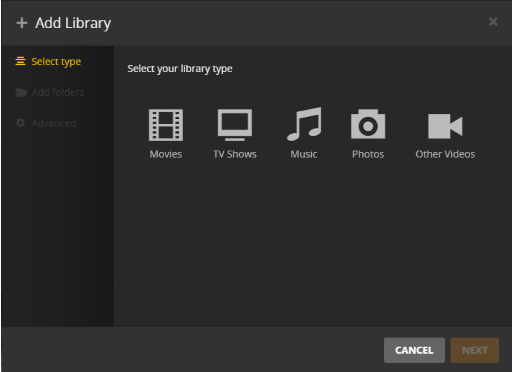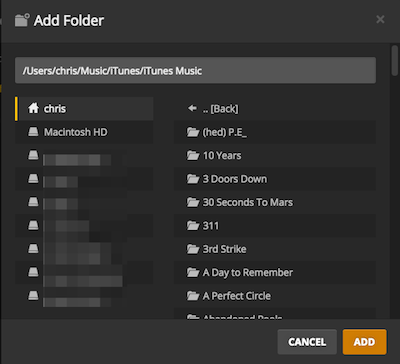Overview
To create a library, launch the Plex Web App then:
- Click
 to open the settings menu
to open the settings menu - Ensure that the correct Plex Media Server is selected within the settings menu
- Select Libraries under the Manage section of the settings menu
- Click Add Library
- Choose the library type from the selection
- Name the library and choose the language to use for information gathered from the internet. Click

- Next, add the folders with the media files. Click

- Choose the folder to add then click
 . To remove a folder, click
. To remove a folder, click 
- Once you’ve added all the source folders for this library, click

Tip!: If adding a new library to an existing server, you may need to restart a client/player app to pick up the new library.
Related Page: Opening Plex Web App
Detailed Information
Select type
You’ll first need to set some general information for the library.
Select a type of media for this library
Choose the basic type of media this library represents.

Available choices:
- Movies
- TV Shows
- Music
- Photos
- Other Videos
Once you’ve selected the library type, you’ll be able to change the name and language.

Name
Enter a name for your library.
Language
Each library has a language that controls the information gathered from the internet. If a library’s language is set to French, for example, the French plot summary, etc., will be downloaded when available.
Add folders
Select the folders where your content is located. Content in the folders must prepared like the examples linked on the Add folders tab. More information is available in the Your Media section.

Use the Browse for Media Folders button to open a dialog where you can browse to the location or enter the path.

You can specify one or more content locations. If you specify multiple locations, content will all be consolidated together for your library.
Do NOT use the root of your drive such as D:/ as a folder location. It will cause various problems. Make an appropriate folder and put your media in that, such as D:/Movies.
Advanced
Most users won’t need to alter the Advanced options, but they’re available when necessary. The options available will vary depending on the type of library you selected.
Tip!: Users with television libraries where the content is based on the season/episode ordering specifically from The TVDB (as opposed to that used on The Movie Database) should look at the Episode ordering advanced setting discussed below.

A few settings are available for all library types:
Scanner
Choose the Scanner to use with your library. Scanners analyze the folder structure and filename of your content for information about that particular item. The default Scanner is automatically selected when you create the library but you can change it if necessary. To change the Scanner, click the dropdown and select the one you want to use.
Related Page: Scanners & Agents
Agent
Choose the Agent to use with your library. Agents take the information from the Plex Scanner, then search local media and internet sites for metadata about the media. The default Agent is automatically selected when you create the library but you can change it by clicking the dropdown and selecting the one you want.
Related Page: Scanners & Agents
Visibility
This setting determines whether content from this library will be included in global search or not. If disabled you can only search the library when in the libraries screens
Advanced (Common for Video Libraries)
Many advanced options are common between library types.
Enable video preview thumbnails
Choose whether or not video preview thumbnails will be generated for this particular library if the main setting is enabled for the Plex Media Server. If you wish to have video preview thumbnails for a particular library:
- Enable the main setting under Settings > Server > Library
- Enable this advanced per-Library setting
Similarly, if you want video preview thumbnails generated in general but not in a particular library, then you can disable it for that specific library.
Related Page: Library
Related Page: Video Preview Thumbnails
Certification Country
By default, Plex will use certification ratings from the United States. If you would prefer to see certification ratings based on a different country, you can change that here. Ratings from every country may not be available for every item, but they’ll be used when possible. Changing this setting will require refreshing the metadata for the changes to take effect.
Use original titles
Use the original titles for all items, regardless of the library language.
Prefer artwork based on library language
Use localized posters when available. This is determined by the library language setting.
Use local assets
When scanning and refreshing this library, use local posters and artwork if present.
Related Page: Local Media Assets - Movies
Related Page: Local Media Assets - TV Shows
Prefer local metadata
When scanning this library, prefer embedded tags and local files if present.
Find extras (Plex Pass required)
When enabled, trailers and extras will automatically be retrieved for your movies when available. (Plex Pass required)
Only show trailers (Plex Pass required)
When enabled, extras that are not trailers will be skipped. (Plex Pass required)
Allow red band trailers (Plex Pass required)
When a “red band” trailer is available, use that when adding a trailer to your library. (Plex Pass required)
Localized subtitles (Plex Pass required)
When available, include additional extras that have subtitles matching your library’s language. (Most users will prefer to not have this enabled.) (Plex Pass required)
Include adult content
Allow matching adult titles and returning adult titles in fix match results.
Collections
Choose how collections and items belonging to a collection are displayed by default when browsing the library content. This default behavior can be overridden when editing a particular collection, if desired. Options:
- Hide collections but show their items: Items that belong to a collection are shown inline and the collection itself is not displayed. The collection is still available when viewing the library by Collection (rather than browsing the library content).
- Hide items which are in collections: If an item belongs to a collection, do not show the item in the main library when browsing. Entries for collections are shown inline.
- Show collections and their items: Entries for collections are shown inline and items belonging to a collection also still appear in the main library when browsing.
Related Page: Collections
Enable credits detection (Plex Pass required)
Detect credits and allow credits skipping for items in this library, when enabled in server settings.
Related Page: Credits Detection
Ad detection (Plex Pass required)
Generate ad/commercial markers for items in this library. Available options are:
- Disabled: Never try to detect ads for content in this library.
- For recorded items: Generate ad/commercial markers for content that is recorded into this library via a Plex DVR. (default)
- For all items: Generate ad/commercial markers for all content added to this library
Related Page: Removing Commercials
Related Page: Live TV & DVR (Set Up and Manage)
Enable voice activity detection (Plex Pass required)
Detect voice activity for items in this library when enabled in server settings. This is required for subtitle auto-sync functionality.
Related Page: Auto-Sync Subtitles
Advanced (Movies)
Enable Cinema Trailers
Determine whether or not the Cinema Trailers feature will be available and active for this library.
Settings to control actual playback are available in the Plex apps themselves.
Related Page: Cinema Trailers, Extras, & Related Albums
Minimum automatic collection size
Automatically create collections when there are at least the selected number of items for an available collection. Changing this value will have no effect on any existing collections. The collection data comes from The Movie Database website. (Examples: Setting 3 means that there must be three movies in a collection before it is automatically created. Disabled means that no collections will be created automatically.)
Related Page: Collections
Rating Source
Choose the source to use for critic ratings for the movies. Options:
- Rotten Tomatoes (default)
- IMDb
- The Movie Database
Advanced (TV Shows)
Episode sorting
Choose how episodes are sorted for television shows. The default ordering is Oldest first, but you can choose to view the episodes by Newest first, if preferred.
Episode ordering
By default, Plex assumes that you have named and organized your television content following how it is listed on The Movie Database. However, if you instead follow the standard organization of TheTVDB instead, you can select that.
Use season titles
When available, use more descriptive titles/names for the seasons (instead of just “Season 1”, “Season 2”, etc.).
Seasons
Choose how seasons are displayed, when viewing a show. This is the default behavior for a library, but the behavior for a particular show can be overridden by editing that show.
- Show: Always show all seasons.
- Hide for single-season series: When you have episodes from only a single season of the show, display those episodes directly on the show page. When multiple seasons are present, show the seasons. (This is particularly useful for miniseries.)
- Hide: Never show seasons and instead list all episodes, from all seasons, directly on the show page.
Enable Intro Detection (Plex Pass required)
Detect intros and allow intro skipping for items in this library when enabled in server settings.
Related Page: Skip TV Show Intros
Advanced (Music)
Import from iTunes
Enabling this option will attempt to import your music playlists from iTunes. It will also import your ratings, the date you added the music, as well as play and skip counts for tracks in your library.
This option requires that iTunes be installed in the default location on the computer running Plex Media Server.
Use embedded tags
When scanning this library, base the content matching only off of the embedded metadata tags (e.g. ID3 tags for MP3 files.).
Store track progress
The server will remember where you left off in a track. Playing that track in a supported app will then resume from where you left off.
Use genre tags from Last.fm
When this option is enabled, genre information from Last.fm will be used instead of embedded metadata. (Available when using the “Last.fm” agent.)
Download concert information
Upcoming concert information can be gathered from Last.fm. When available, it can be displayed on the artist’s page.
Download popular track information
Gather data from Last.fm about which tracks for particular artists are most popular. When available, those popular tracks are displayed on the artist’s page.
Download album reviews
When this option is enabled, album reviews from Gracenote will be gathered when available. (Available when using the “Plex Premium Music” agent.)
